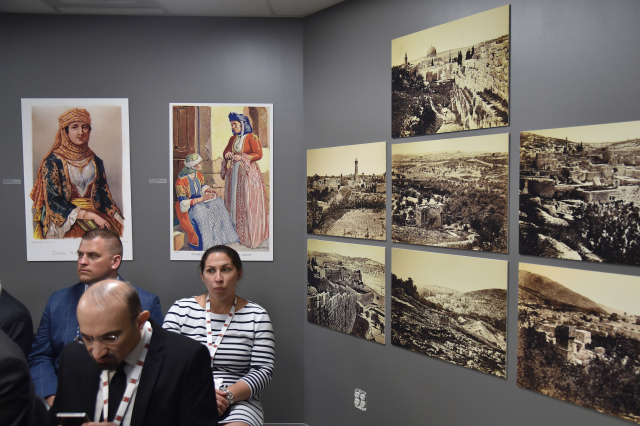
A bucolic Connecticut town may have outwardly little in common with the Middle East, but it’s home to a new art museum hoping to change US attitudes toward the Palestinians.
Tucked away in Woodbridge, an affluent community near Yale University 80 miles (128 kilometers) north of Manhattan, it is well off the museum circuit and the bright lights of a big city, at least for now.
The achievement is that it exists at all, funded on a shoe-string budget of half-a-million dollars, and nine months in the making by its Palestinian-American businessman founder, determined to create the first museum dedicated to Palestinian art in the United States.
Israel’s imminent 70th anniversary, the prospective US embassy move to Jerusalem, Washington’s close relationship with the Jewish state, past suicide bombings and headlines about stabbing attacks overshadow much of the US discourse about the Israeli-Palestinian conflict.
“The media and the forces that are not friendly to Palestine have painted the Palestinians in a very negative light and in some ways they were dehumanized,” museum founder Faisal Saleh, 66, told AFP.
His hope is for everyday Americans to visit and discover that the Palestinians have a rich artistic heritage.
“We have our own artists, just like everyone else has their own artists, and we have a disproportionate number,” he said. “A lot of them are working under very austere conditions.”
Called Palestine Museum US, it will open to the public this Sunday and for now will open only Sundays, free of charge and staffed by volunteers. It houses more than 70 works of art, 100 photographs, collections of embroidery, costumes and several modern installations.
While it’s about art, not war, and the museum offers little education on the Israeli-Palestinian conflict itself, the longing for land, for peace and for self-determination permeates much of the work.
Palestinians commemorate the anniversary of Israel’s creation in 1948 as the “nakba” or “catastrophe” that forcibly displaced or sent into exile the first of successive waves of Palestinian refugees.
“Creative rather than backward”
“Art always expands your thinking,” says Samia Halaby, 81, a prominent Palestinian artist who lives and works in New York. Three of her pictures hang in the gallery space.
“I hope they will learn more about our existence as a people, see us as being creative rather than backward victims, as the press is prone to present us,” she told AFP.
“It is something that is accomplished a great deal by museums all around the world for other cultures and other ideas.”
The airy 4,000 square feet (371 square meters) of gallery space, with sunlight flooding through the windows, starts with old photographs of Jerusalem under the British Mandate, and leads through to contemporary and abstract paintings.
Featuring the work of 29 artists, many living in Israel, the West Bank and the Gaza Strip, Saleh says it is proof of a concept that can be transported on a bigger scale.
“We are hoping that very soon other Palestinian entrepreneurs will join and fund the ultimate objective, which is creating a much larger museum in a major city, such as in New York or Washington DC,” he said.
This is a tall order, but the Ramallah-born Saleh says initial reactions have been “phenomenal,” already generating press coverage focused on Palestinian art rather than conflict.
“It’s a very peaceful activity,” he said. “We want to share our art with the people and I don’t see why anybody would have a problem with it.”
Timothy Niedermann, an editor and author of a novel about a Palestinian schoolteacher, was one of those who attended an invitation-only opening ceremony last weekend.
“Our negative image is perhaps more than partially justified in terms of the terrorist experience but we don’t know anything else. So this is going to give us a picture of ‘yes normal people live there.'”
“And that’s what really needs to be said. Normal people with whom one can have a normal conversation and perhaps arrive at normal solutions.” CC
RELATED STORIES:
From Palestinian refugee camp to London, Paris, Dubai boutiques
Spanish exhibition gives platform to Middle Eastern female artists